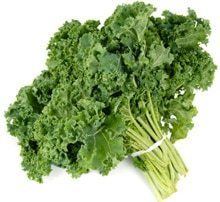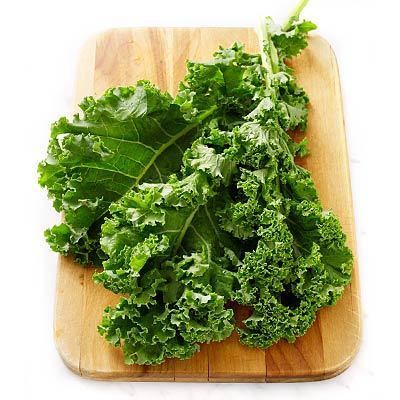Cultivar group members Many; see text. | Cultivar group Acephala Group | |
 | ||
Similar Spinach, Broccoli, Cabbage, Marrow‑stem Kale, Cauliflower | ||
10 proven benefits of kale
Kale ( /keɪl/) or leaf cabbage refers to certain vegetable cultivars of the plant species Brassica oleracea. A kale plant has green or purple leaves and the central leaves do not form a head (as with headed cabbages). Kales are considered to be closer to wild cabbage than most domesticated forms of Brassica oleracea.
Contents
- 10 proven benefits of kale
- Kale superfoods episode 5
- Etymology
- History
- Description
- Cultivars
- Cultivation
- Ornamental kale
- Nutritional value
- Phytochemicals and health
- Culinary uses
- Regional uses
- Europe
- Asia
- In literature
- References
Kale superfoods episode 5
Etymology
Kale bears semblance to "kail", a variant of "cawul" (from Scotland and northern England) for various cabbages.
History
Until the end of the Middle Ages, kale was one of the most common green vegetables in Europe. Curly-leaved varieties of cabbage already existed along with flat-leaved varieties in Greece in the fourth century BC. These forms, which were referred to by the Romans as Sabellian kale, are considered to be the ancestors of modern kales.

Russian kale was introduced into Canada, and then into the United States, by Russian traders in the 19th century.

During World War II, the cultivation of kale in the U.K. was encouraged by the Dig for Victory campaign. The vegetable was easy to grow and provided important nutrients missing from a diet because of rationing.
Description

Some varieties can reach a height of six or seven feet, while others are compact, symmetrical and of good quality for eating. Many, however, are coarse and indigestible. Most kales are annuals or biennials. Kale seeds resemble those of cabbage in size, form, and color.
Cultivars

One may differentiate between kale varieties according to the low, intermediate, or high length of the stem, along with the variety of leaf types. The leaf colours range from light green to green, to dark green and violet-green, to violet-brown.
Classification by leaf type:
Because kale can grow well into winter, one variety of rape kale is called "hungry gap" after the period in winter in traditional agriculture when little else could be harvested. An extra-tall variety is known as Jersey kale or cow cabbage. Kai-lan or Chinese kale is a cultivar often used in Chinese cuisine, but in English it is occasionally just called "kale". In Portugal, the bumpy-leaved kale is mostly called "couve galega" (Galician kale), although in some regions other names may be used.
Cultivation
Kale is usually an annual plant grown from seed with a wide range of germination temperatures. It is hardy and thrives in wintertime.
Ornamental kale
Many varieties of kale and cabbage are grown mainly for ornamental leaves that are brilliant white, red, pink, lavender, blue or violet in the interior of the rosette. Ornamental kale is as edible as any other variety, but potentially not as palatable.
Nutritional value
In a 100 gram serving, raw kale provides 49 calories. Like collards, it is very high in vitamin K. It is also a rich source (20% or more of the Daily Value, DV) of vitamin A, vitamin C, vitamin B6, folate, and manganese (see table "Kale, raw"). Kale is a good source (10–19% DV) of thiamin, riboflavin, pantothenic acid, vitamin E and several dietary minerals, including iron, calcium, potassium, and phosphorus (see table "Kale, raw").
Boiling raw kale diminishes most of these nutrients except for vitamin K (see table "Kale, cooked [...]").
Phytochemicals and health
Kale is a source of the carotenoids lutein and zeaxanthin (tables).
As with broccoli and other cruciferous vegetables, kale contains glucosinolate compounds such as glucoraphanin, which contributes to the formation of sulforaphane, a compound under preliminary research for its potential to affect human health. Boiling kale decreases the level of glucosinate compounds, whereas steaming, microwaving or stir frying does not result in significant loss.
Culinary uses
Kale freezes well and tastes sweeter and more flavourful after being exposed to a frost. Tender kale greens can provide an intense addition to salads, particularly when combined with other strongly flavoured ingredients like dry-roasted peanuts, soy sauce-roasted almonds, red capsicum flakes, or sesame-based salad dressings.
Flavored "kale chips" have been produced as a potato chip substitute.
Regional uses
In the Southern United States, kale is often served braised, either alone or mixed with greens like collard, mustard, or turnip. It is also used in salads. In Brazil, it is a side dish for a common stew called feijoada. Various kale types are eaten throughout southeastern Africa, where they are typically boiled with coconut milk and ground peanuts and served with rice or boiled cornmeal.
Europe
In the Netherlands, a traditional winter dish called "boerenkoolstamppot" is a mix of curly kale and mashed potatoes, sometimes with fried bacon, and served with rookworst ("smoked sausage").
In Italy, cavolo nero is an ingredient of the Tuscan soup ribollita. Kale (cavolo nero) is part of many dishes, such as "casseoula" (pork stew) and polenta (corn porridge).
A whole culture around kale has developed in northern Germany, especially around the towns of Bremen, Oldenburg, Osnabrück and Hannover and the region of Dithmarschen. There, most social clubs of any kind will have a Grünkohlessen or Kohlfahrt ("kale tour") sometime between October and February, visiting a country inn to consume kale stew, pinkel sausage, kassler, mettwurst and schnapps. Most communities in the area have a yearly kale festival which includes naming a "kale king" (or queen).
Curly kale is used in Denmark and southwestern Sweden (Scania, Halland and Blekinge) to make (grøn-)langkål (Danish) or långkål (Swedish), an obligatory dish on the julbord in the region, and is commonly served together with the Christmas ham (Sweden). The leaves of the kale are separated from the stem, and then boiled with stock. The result is drained and pressed to remove the remaining liquid. The kale can now be frozen for up to 6–8 months if needed. To make langkål, finely chop the (defrosted) kale and fry it with cream, pepper, and syrup (or sugar) for sweetening. In Sweden, it is also commonly eaten as a soup, with a base of ham broth and the addition of onion and pork sausages.
A traditional Portuguese soup, caldo verde, combines pureed potatoes, diced kale, olive oil, broth, and, generally, sliced, cooked spicy sausage.
In Montenegro, collards and kale, locally known as rashtan, is a favorite vegetable. It is particularly popular in the winter, cooked with smoked mutton (kastradina) and potatoes.
In Scotland, kale provided such a base for a traditional diet that the word in Scots dialectics is synonymous with food. To be "off one's kail" is to feel too ill to eat.
In Ireland, kale is mixed with mashed potatoes to make the traditional dish colcannon. It is popular on Halloween, when it may be served with sausages.
In Turkey, especially in the eastern Black Sea region, kale soup (karalahana çorbası), kale sarma, kale kavurma (sauté), and kale turşu are common dishes.
Asia
A variety of kale, kai-lan, is a popular vegetable in China, Taiwan, and Vietnam, where it is commonly combined with beef dishes. In Japan, kale juice (known as aojiru) is a popular dietary supplement.
In literature
The Kailyard school of Scottish writers, which included J. M. Barrie (creator of Peter Pan), consisted of authors who wrote about traditional rural Scottish life (kailyard = kale field). In Cuthbertson's book Autumn in Kyle and the charm of Cunninghame, he states that Kilmaurs in East Ayrshire was famous for its kale, which was an important foodstuff. A story is told in which a neighbouring village offered to pay a generous price for some kale seeds, an offer too good to turn down. The locals agreed, but a gentle roasting on a shovel over a coal fire ensured that the seeds never germinated.
